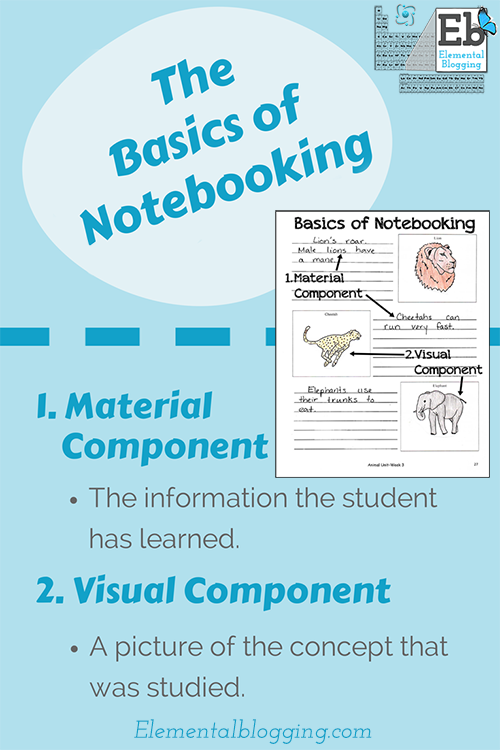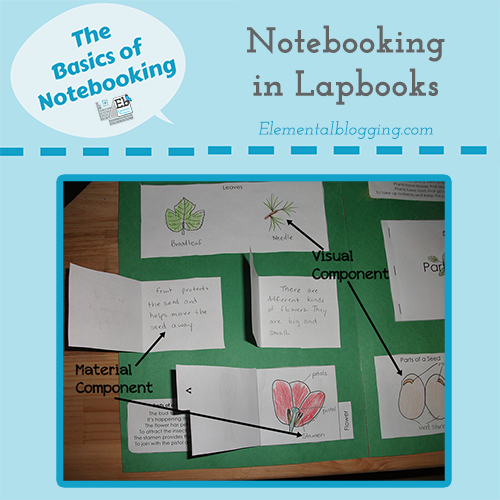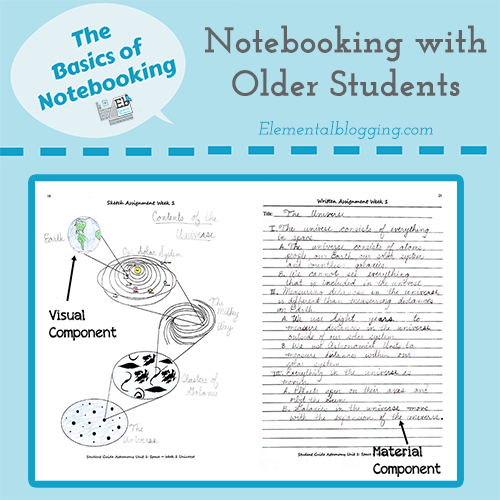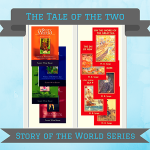 I recommend notebooking over straight comprehension worksheets during the elementary and middle school years because it is an excellent way of engaging the student with the information he is learning.
I recommend notebooking over straight comprehension worksheets during the elementary and middle school years because it is an excellent way of engaging the student with the information he is learning.
In notebooking, the student is not merely regurgitating facts; he is thinking over what he has read or heard and responding with what he has found to be meaningful.
Notebooking is an extremely effective tool that, over time, will teach the student how to process and release information.
The Key Components of Notebooking
Notebooking has two key components:
- Material Content
- Visual Content
The material component of notebooking contains the information the student has learned, while the visual component of notebooking displays a picture of the concept he has studied. Both are equally important since they each engage different parts of the student’s brain.
Using these two components hand in hand will help to solidify the information into the student’s mind as well as train him how to share what he knows.
However, how you arrange the two components of notebooking is up to you and the student. The key elements can be displayed through:
- Notebooking Pages
- Lapbooks
- Booklets
- Posters
Notebooking through the Years
Notebooking is one of those assignments that can mature and grow with your students.
I like to compare elementary students to an empty bucket that is waiting to be filled with information. Notebooking is the go-to tool you can use to verify that they have placed a piece of information into his bucket.
As the students move into the middle school years, they have a filled bucket of information, but the material still needs to be added to and organized during these years. Notebooking remains a handy method that you can use to help him arrange the data that is swimming around in his head.
Notebooking Examples
In first grade, notebooking can be very basic. For example, after you have read about the flowers, simply ask, “What is one thing that you learned about flowers? or “What do you like best about the flowers?” Once you have written the answer down for him, you can have him add a picture of flowers. This can be a picture that you have printed or one that the student has drawn and colored.

Around the third grade, notebooking begins to increase in difficulty. At this age, the student should be able to begin writing his own answers, or narrations, for his notebooking pages. His narrations can be in paragraph form or in list form. You can still ask him broad questions like, “What are several things that you learned about the alkali metals?” Once he has finished writing, you can have him paste in a picture of the alkali metal group. It is important to note that as the student gets older, you are still making use of the visual component. You don’t want to neglect this step because the pictures will serve as visual markers of the concept in the student’s mind.
As the student continues to mature, his notebooking will reflect his growing intellect. His material component will include longer paragraphs or outlines and his visual component will turn into sketches or diagrams. In addition, instead of asking simple broad questions about his favorite parts, you will ask leading questions that will help him to pull out the most important information from what he reads. So, in sixth grade the student will be coloring and labeling a sketch that comes from what he studied as well as crafting an outline or a report from what he read. This type of notebooking looks a bit different than it did in earlier years, but it is still equally as effective.
Notebooking Help
The material and visual components of notebooking serve as two interlocked parts that will help you to firmly affix key pieces of information into the student’s brain. Here are some resources to get you started:
- Notebooking Fairy: Jimmie shares a variety of notebooking pages as well as interviews people who consistently notebook. Her site is a wealth of notebooking information.
- Elemental Science: We believe in the benefit of notebooking so much that we have incorporated the components into each one of our programs.
- Homeschool Share: This site contains a large collection of lapbooks available for free download. Lapbooks are a great way to incorporate notebooking with a student who is more creative or with one who is reluctant to write.
I encourage you to try notebooking this week, if you haven’t already! If you have any questions about notebooking, please leave them in the comments below.










[…] but they can also include pictures or projects that the student has completed. In the same way that notebooking does not require regurgitation of facts; lapbooking causes the student to interact with the […]